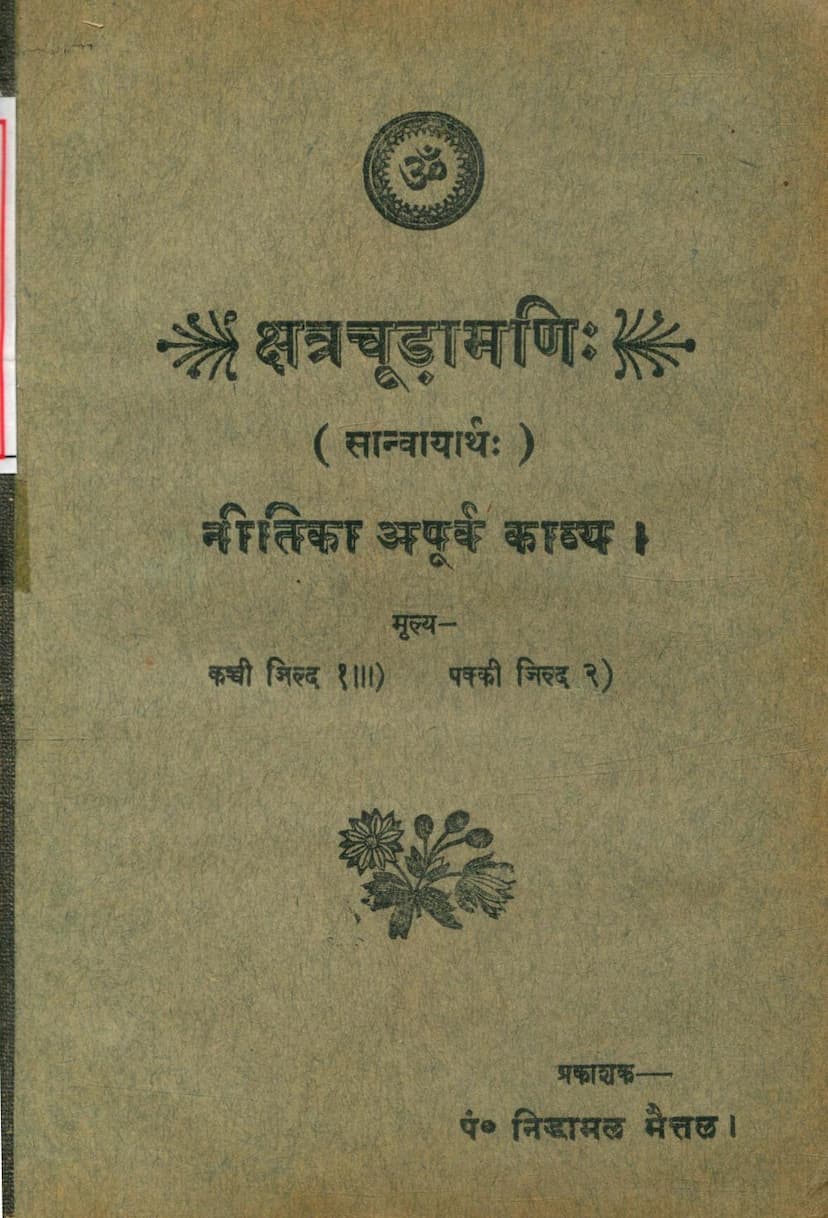Kshatrachudamani
Added to library: September 2, 2025

Summary
Here's a comprehensive summary of the Jain text "Kshatrachudamani" by Niddhamal Maittal, based on the provided pages:
Book Title: Kshatrachudamani (क्षत्रचूड़ामणिः) Subtitle: Sānvayārtha (सान्वायार्थः) - With Explanatory Meaning Author of Commentary: Pandit Niddhamal Maittal (पं० निडामल मैत्तल) Original Author: Shrimad Vadibhasimha Suri (श्री महादीभसिंह सूरि) Publisher: Pandit Niddhamal Maittal, Saharanpur Printer: Moolchand Kisandas Kapadia, Jainvijay Printing Press, Surat Year of Publication: Vira Nirvana Samvat 2447 (श्री वीर निर्वाण सं० २४४७)
Overall Purpose of the Commentary: Pandit Niddhamal Maittal explains his intention behind creating this commentary. He notes that the original text, "Kshatrachudamani," is an "unprecedented poem of ethics." His goal is to make this valuable work accessible to students and scholars of Jainism who are learning Sanskrit. He observes that students often forget the narrative due to its brevity, and the commentary aims to provide a clear, sequential explanation to aid their understanding and retention. He also apologizes for potential inaccuracies due to the distance from the printing press and asks readers to use the errata sheet.
Summary of the Narrative (Based on the chapter summaries provided):
The text narrates the life story of Shri Jivandhara Swami (श्री जीवंधर स्वामी), a prominent figure in Jain tradition. The narrative is divided into eleven "lambas" or sections, each detailing a significant phase of his life.
Key Events and Themes Across the Lambas:
-
Early Life and Birth: The story begins with King Satyandhara of Rajapuri and his virtuous queen Vinaya. Vinaya has auspicious dreams, indicating the birth of a powerful son who will face great challenges. The king, deeply devoted to his queen, creates a flying peacock-shaped machine for her safety. Due to political intrigue, the king is killed by his minister, Kashtangara, who seizes the throne. Vinaya, in hiding, gives birth to a son in a cremation ground. A goddess appears in the guise of a nurse and assures Vinaya of her son's future protection. The child is found and adopted by the merchant Gandhotkata and named Jivaka (later Jivandhara).
-
Education and Spiritual Guidance: Jivandhara receives education from the learned Acharya Aryānandi, who reveals his own past life and spiritual journey. Aryānandi teaches Jivandhara about the impermanence of worldly life, inspiring his detachment.
-
Revenge and Justice: Jivandhara learns about his father's murder and vows revenge against Kashtangara. Despite his youth, he initially refrains from immediate conflict due to his guru's advice. He later demonstrates his prowess by winning a musical contest, leading to his marriage with Gandharvadatta, the king of Gandhara's daughter. He also shows his skill in archery and fighting elephants.
-
Trials and Tribulations: Jivandhara faces numerous challenges, including being imprisoned by Kashtangara. He is rescued by Yaksha Indra (the divine being who was a dog in a past life, due to Jivandhara's merit). He is granted special powers and mantras. He also encounters and helps various individuals, demonstrating his compassion and wisdom.
-
Marriages and Relationships: Jivandhara's life involves several marriages, often resulting from his virtuous actions and the fulfillment of prophesies. Notable marriages include Gandharvadatta, Gunamala, Kshemashri, Padmavati, and Suramanjari. Each marriage often involves overcoming obstacles or demonstrating his virtue. His relationships with his wives and his brother Nandadhya are explored.
-
Wider Influence and Actions: Jivandhara's influence extends beyond his personal life. He aids merchants in distress, resolves disputes, and demonstrates his profound understanding of ethics and dharma. He is shown to be a skilled diplomat, warrior, and spiritual guide.
-
Encountering Dharma: Throughout his life, Jivandhara constantly encounters situations that reinforce his understanding of Jain principles – karma, dharma, detachment, compassion, and the impermanence of the world. His encounters with ascetics and his own contemplation lead him towards renunciation.
-
Attaining Liberation (Moksha): In the final stages of his life, after fulfilling his worldly duties and establishing his son Satyandhara on the throne, Jivandhara, along with his mother Vinaya, brother Nandadhya, and his wives, renounces the world and takes diksha (initiation into asceticism) under a Jain monk. Through rigorous penance and adherence to Jain principles, he ultimately attains Moksha (liberation).
Key Philosophical and Ethical Teachings Highlighted:
- Karma Theory: The text strongly emphasizes the law of karma – how actions in past lives influence present circumstances and how current actions shape future destinies. Jivandhara's own life is a testament to this, with his past good deeds leading to favorable outcomes and his present challenges serving as tests.
- Dharma and Ethics: The story serves as a guide to ethical conduct, illustrating the importance of compassion, truthfulness, non-violence (ahimsa), detachment, and righteous living.
- Impermanence of the World: A recurring theme is the transient nature of wealth, power, and even life itself, encouraging detachment from worldly possessions and pleasures.
- The Power of Virtue: Jivandhara's virtues, particularly his compassion, wisdom, and unwavering commitment to dharma, are repeatedly shown to overcome obstacles and lead him to success.
- Importance of Knowledge and Wisdom: The text highlights the transformative power of true knowledge and wisdom, both worldly and spiritual, in navigating life's challenges and achieving liberation.
- The Role of the Guru: The guidance and teachings of gurus like Aryānandi and Charuna Muni play a crucial role in Jivandhara's spiritual development.
The Commentary's Contribution:
Pandit Niddhamal Maittal's "Sānvayārtha" aims to illuminate the moral and philosophical underpinnings of Jivandhara's life story, making it a valuable resource for understanding Jain ethics and the path to spiritual liberation. The commentary breaks down the narrative verse by verse, ensuring clarity and accessibility for a wider audience.